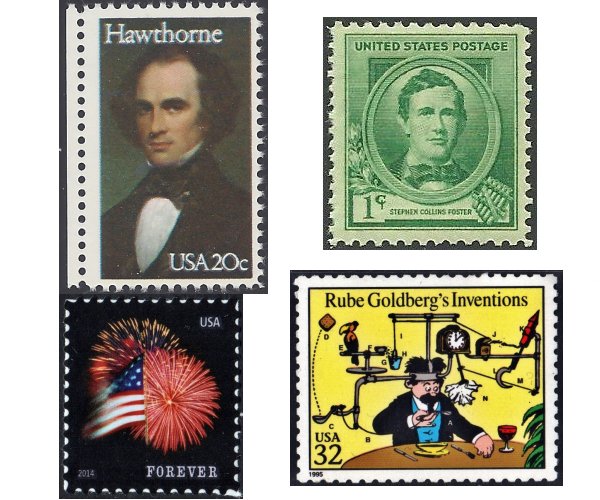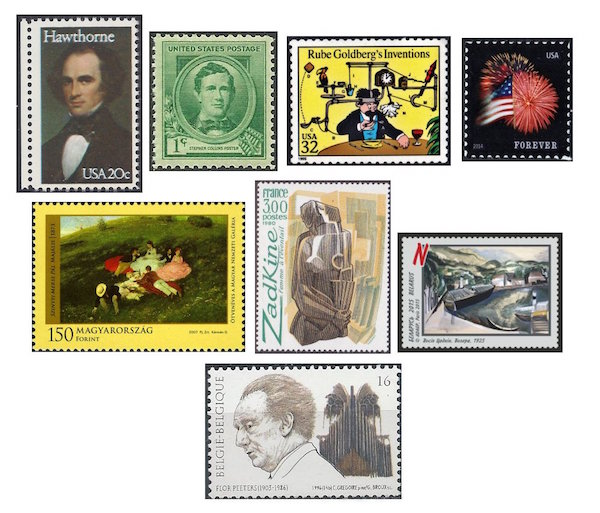The Arts on Stamps of the World — July 4
An Arts Fuse regular feature: the arts on stamps of the world.

By Doug Briscoe
Appropriately enough, on this Fourth of July it is three Americans who are our most celebrated figures: Nathaniel Hawthorne, Stephen Foster, and Rube Goldberg. We also salute Hungarian painter Pál Szinyei Merse (PAHL SIN-yay MAIR-sheh), Russian sculptor Ossip Zadkine, and Belgian composer Flor Peeters.
When I was nineteen years old and visiting my sister in Los Angeles, I found in an antiquarian bookstore a complete set of Hawthorne in 22 volumes of handsome red half-leather and marbled binding, dated 1906. $110. One of the happiest purchases of my bibliophilic life. (The books had been printed in Cambridge, somehow wound up in California, and were rescued and brought home by my teenaged self.) Forty years have passed, and I’ve still read only half the volumes. I’d better accelerate my schedule. Nathaniel Hawthorne (July 4, 1804 – May 19, 1864) was born in Salem and altered the spelling of his name, adding a “w” to Hathorne so as to disguise his descent from the detestable Puritan witch burner John Hathorne. The writer has long been one of my favorites, perhaps particularly for the grateful short stories of such collections as the Twice-Told Tales and Mosses from an Old Manse. The story of Hawthorne’s passing has always affected me. He was travelling in the White Mountains of New Hampshire with his friend, former President Franklin Pierce. One night Pierce was awakened by a barking dog. He rose from his bed and went through the open adjoining door between their rooms and discovered that his companion had died in his sleep. Hawthorne’s shade had to wait until 1983 before his image appeared on a U.S. stamp.
In the days before copyright law, Stephen Foster (1826 – January 13, 1864) saw little profit from his enormously popular songs—”Oh! Susanna”, “Camptown Races”, “Old Folks at Home”, “Jeanie with the Light Brown Hair”, “Beautiful Dreamer”, to name a few—and he died impoverished at the age of 37. The stamp comes from a large set issued in 1940 to honor American authors, poets, educators, scientists, composers, artists, and inventors, with five stamps per category. Foster is primus inter pares among the composers in the sense that he appears on the 1-cent denomination.
Born Reuben Garrett Lucius Goldberg in San Francisco, Rube Goldberg (July 4, 1883 – December 7, 1970) took professional drawing lessons as a child and worked for the San Francisco Chronicle as a sports cartoonist before moving to New York. With syndication his work became so popular that when the Hearst papers offered him $50,000 a year in 1915, the New York Evening Mail matched the offer to keep him. Goldberg was the creator of several comic strips including Mike and Ike (They Look Alike) and Boob McNutt, but his most memorable character was Professor Butts, the inventor of the famous Goldbergian devices like the Self-Operating Napkin (1931) seen on the postage stamp, one from a sheet recalling classic American comic strips. (The Inventions of Professor Lucifer Gorgonzola Butts ran from 1914 to 1964.)
For the holiday I offer a stamp that I daresay you will have seen before.

One can plainly see from his bearing in the 1897 self-portrait that Hungarian painter Pál Szinyei Merse (4 July 1845 – 2 February 1920) was of the nobility. He studied art in Munich and set up shop there close to the studio of his friend Arnold Böcklin. A stream of abuse from critics, however, led him to quit painting for a full decade. He went through a divorce and reared his son until the lad had left the nest, whereupon friends urged Merse to take up the brush once again. Merse did so, was elected to the Diet of Hungary, exhibited all around Europe and even in St. Louis, and was named President of the Hungarian University of Fine Arts in 1905. One of his pre-crisis works, seen on the stamp, is Picnic in May of 1873.
Another Eastern European artist was Ossip Zadkine, born in Vitebsk in 1890. There is disagreement about his date of birth, with some sources citing 4 July, others 14 July. (It doesn’t seem to be a New Style vs. Old Style issue, as the difference between those two calendars in 1890 was a matter of twelve days, not ten.) Zadkine’s father was Jewish, his mother of Scottish origin, and Zadkine went to school in London. He moved to Paris at twenty and joined the Cubists. He was wounded while serving as a stretcher-bearer in World War I. In 1921 he adopted French citizenship, but lived in the United States during World War II, where he formed a friendship with Henry Miller. (The character of Borowski in Tropic of Cancer is a portrait of Zadkine.) Zadkine died in Paris on 25 November 1967. Although best known as a sculptor, strongly influenced by Rodin, he also produced paintings, as can be seen from the Belarusian stamp, which reproduces The Lake (1925). The sculpture on the French stamp is of Zadkin’s 1923 bronze Woman with a Fan. One of the artist’s most poignant works is The Destroyed City (1951-1953), a memorial to Rotterdam, the center of which was nearly obliterated by the Luftwaffe in 1940. My online researches turned up this striking portrait of Zadkine by Marie (Marevna) Vorobieff (1892–1984).
Flor Peeters (1903-1986) was much in demand as an organist and teacher all around the world. Most of his 100 compositions are for the organ and/or choir, and he left many recordings of the organ repertoire of the 16th through 18th centuries. I got to know his work through an old Argo LP of his attractive Missa Festiva of 1947. He died on his 83rd birthday.
A graduate of the University of Massachusetts with a B.A. in English, Doug Briscoe worked in Boston classical music radio, at WCRB, WGBH, and WBUR, for about 25 years, beginning in 1977. He has the curious distinction of having succeeded Robert J. Lurtsema twice, first as host of WGBH’s weekday morning classical music program in 1993, then as host of the weekend program when Robert J.’s health failed in 2000. Doug also wrote liner notes for several of the late Gunther Schuller’s GM Recordings releases as well as program notes for the Boston Classical Orchestra. For the past few years he’s been posting a Facebook “blog” of classical music on stamps of the world, which has now been expanded to encompass all the arts for The Arts Fuse.
